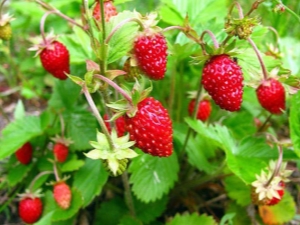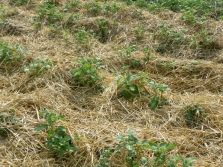Strawberry "Alexandrina": description of the variety and cultivation

Strawberry "Alexandrina" is well known to Russian summer residents.The plant gives a rich harvest and due to its high decorative properties it is often used for vertical and horizontal types of gardening.
Specifications
“Alexandrina” is a remontant variety, which means the ability to multiple flowering and fruiting during one season. Repair varieties, unlike garden varieties, begin to bear fruit in the second half of May and end after the onset of the first frost. A distinctive feature of remontant varieties is a large number of berries only in the first two years after planting.
Further, the yield drops noticeably, which often requires the complete replacement of plantations. In addition, experienced gardeners note that in their taste characteristics, repairers are slightly inferior to representatives of once-flowering varieties, therefore, they plant “Alexandrina” as a source of berries not so often.
"Alexandrina" is capable of reproduction only with the help of seeds and refers to wild species of strawberries. This makes it possible to fully transfer all the properties of the parents to the new generation. One of the most important characteristics in the description of the variety is its resistance to temperature extremes. This makes it possible to grow strawberries in many regions of the country, with the exception of zones with a sharply continental climate and northern territories.
Adult plants "Alexandrins" are represented by relatively high compact bushes.reaching a height of 15–20 cm, however, some individuals often grow up to 25 cm. The leaf blades of strawberries are large, which requires an increase in the distance between adjacent shoots when they are planted in open ground. A distance of 25-30 cm is considered comfortable. With this arrangement, the shoots will not compete for water and nutrients, as well as shade each other. Flowering of strawberries begins in May, and the first fruiting occurs either in May or in early June. Vegetation periods may slightly shift in one direction or another, and are completely dependent on the climatic conditions of the area and the thoroughness of care. Fruits plants until mid-October, until the night temperature starts to drop below zero.
The berries are distinguished by an oblong shape, bright red color and a sweet-sour pleasant taste, and their score on a five-point tasting scale is 4 points. The mass of the berries of the first harvest season significantly exceeds that of the subsequent fruiting. Fruits are not prone to shattering and are able to stay on the bushes for a long time. Over time, they begin to darken and become sweeter.
Advantages and disadvantages
A large number of positive reviews about the grade "Alexandrina" due to a number of indisputable advantages of this species.
- Due to its remontment, the plant is able to bring several harvests per season, which distinguishes it from other varieties.
- Large yield of the first harvest allows you to shoot berries weighing up to 8 g (the average weight of strawberry fruit is usually 3-5 grams).
- Pleasant taste and preservation of the form during cooking allow you to make a variety of strawberries in the winter, including jams and compotes.
- The ability to perfectly remain on the bush after aging significantly simplifies the care of the plant and does not require the constant presence of the owner on the site. Berries do not crumble and do not flow to the ground when precipitation falls.
- High frost resistance allows to grow strawberries in the territory of Western Siberia in areas of high risk farming. Under a thick layer of straw and snow, strawberries tolerate winter well enough, however, a temperature not lower than 25 degrees is considered acceptable. Otherwise there is a risk of freezing of the roots and the death of the plant.
- The variety is characterized by increased resistance to many diseases and pests.
- Strawberry "Alexandrina" has beautiful and bright leaves, so it can be grown as an ornamental plant.
The disadvantages of "Alexandrina" include the absence of a mustachethat entails the impossibility of vegetative propagation and requires annual planting of seeds. Also, there is a certain tendency of plants to the appearance of fungal diseases, which may occur due to a large amount of rain.
However, this problem can be avoided. To do this, you just need to follow the plantation of seedlings, ensuring optimal ventilation of each bush.
Landing
To plant the seeds of "Alexandrina" in the seedlings should be in late February and early March. The best option for germination are biennial seeds, although even a five-year seed is quite viable and retains a high germination rate. The planting technique is somewhat different from the traditional sowing: the seeds are not buried in the ground, but only evenly distributed over its surface, after which they are sprayed from the spray gun. Then the seed box is covered with glass and wrapped in polyethylene. Then every day the bag and glass are removed, and the seeds are ventilated and re-moistened.
To do so is necessary until the first shoots appear. This usually occurs 8-12 days after sowing. As a substrate for planting seeds, you can use a mixture of turf, sand and peat, taken in a 2: 1: 1 ratio.
The prepared mixture is recommended to be placed in the oven and calcined for 20 minutes at a temperature of 180-200 degrees. This will help get rid of harmful microorganisms and eggs of insect pests.
After the appearance of sprouts, the boxes with seedlings are installed in a warm moderately sunny place, and the ingress of ultraviolet rays must be diffuse. Direct sun exposure can harm young, fragile plants and burn them. Dive seedlings should begin after the shoots appear two true leaf, while planting in open ground can be made after the appearance of five leaves. Planting plants on the street can only be done if the threat of night frost has completely passed, and the plants have undergone a hardening procedure.
The essence of this procedure lies in the short-term placement of boxes of seedlings on the street. It should start with a few minutes a day and as the plants get used to finish a few hours. When planting strawberries, experienced gardeners recommend maintaining a distance of 30 cm between the bushes and rows. This will ensure good plant ventilation and eliminate the risk of tangle of shoots.
Care
When growing seedlings is important to the optimum ratio of heat and humidity. In order to prevent over-wetting of the shoots, it is recommended to use a pipette or sprayer. It is necessary to regularly air the seedlings, remembering that the strawberry sprouts are very fragile and can easily break during any careless movement. Loosening the soil and removing weeds should also be done very carefully.
After transplanting plants into the open ground, it is recommended to feed the shoots with the help of any complex fertilizer containing nitrogen. If the available funds are not available, you can make such an additive yourself. For this purpose, an infusion of water and a mullein, prepared in the following way, is quite suitable: an 8-liter bucket is filled with 1/3 volume of cow manure, then topped up with warm water to the edges. After two weeks, the solution is stirred, one liter is scooped out of a bucket, diluted in 10 liters of pure water and the plants are watered.
When fertilizing, you must try to pour the tool directly under the root, without touching the stem and leaves of the shoot.The second and third dressings are carried out during the budding period and during the second wave of color, respectively, and consist in the introduction of phosphorus-potassium compounds. Variety "Alexandrina" is a bisexual species, so does not require artificial pollination.
In the second half of October, the above-ground part of the plants is cut, and the soil around the stem is mulched with sawdust or straw. In this form, under the condition of stable snow cover, the plant tolerates the winter cold perfectly and does not need additional harboring. However, during windy winters, snow over the garden bed can be covered with boards or roofing felt. This will eliminate blowing off the snow cover and prevent the roots of the plant from being bare.
Strawberry "Alexandrina" is quite suitable for novice gardeners. The variety is simple to grow, gives a rich harvest and can be used as an independent element of gardening in the formation of landscape design.
In the next video, see about harvesting strawberries "Alexandrina".



























